Longhorn beetles or longicorns are considered a big family of beetles because of the hundred subspecies. Despite the wide varieties, you can identify them through their long antennae which is the common feature that they all share.
Apart from knowing their looks, it’s also good to know what they do.
Are longhorn beetles dangerous? Longhorn beetles are not harmful or poisonous to humans. Moreover, they don’t bite and sting at all. However, they’re viewed as pests since they can make tunnels through the woods. A tree can die in a few years when inhabited by these insects. Therefore, this activity causes damage to the human economy, specifically to the wood export industry.
Longhorn beetles can also be home invaders. It happens when the wood that came into your house is filled with these insects. Their affinity to wood is alarming since it creates massive destruction and loss.
Eradication programs were set to fight these pests just like what the US APHIS did in 2018. How much damage can they cause as the government works hard on eliminating them? Read on to know more.
What is a Longhorn Beetle? Are They Dangerous?
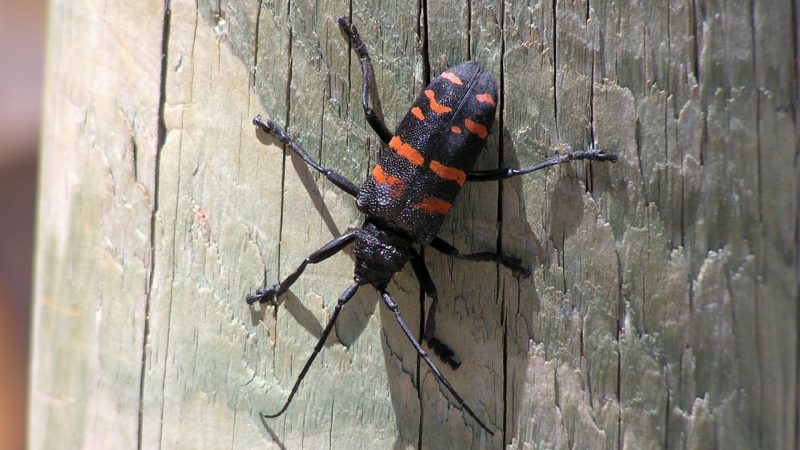
A longhorn beetle is an exotic insect that originally resides in the forests of China, Japan, and Korea. Since this is not native to North America, the trees in the continent have a low resistance to this insect.
In 1996, the infestation was discovered in Long Island, New York. After two years, another longhorn beetle infestation occurred in Chicago’s suburban areas.
The infestation also occurred in Toronto, Ontario in 2003. Furthermore, the same thing happened in New Jersey in 2004. Longhorn beetles have been destroying trees in Europe since 2001, and it continues up to these days. In the northern part of Austria, it took 12 years to eradicate infestation which started in 2001 and ended in 2013. Therefore, the population of longhorn beetles is widespread.
What Does A Longhorn Beetle Look Like?
Longhorn beetles are the usual insects that have thick middle parts and narrow legs. They look strange with their long antennae and beady eyes. When it comes to their length, they can be 2 to 2.3 cm long. The antenna’s length is usually double the size of their bodies.
There are other subspecies like the Asian longhorn beetle. It’s bigger since it’s an inch long and ¾-inch wide. Its whole body is black with white spots on the lower section. The largest among them is the matte black long-jawed longhorn that lives in South America. You’ll find some colorful species too.
What Do Longhorn Beetles Eat?
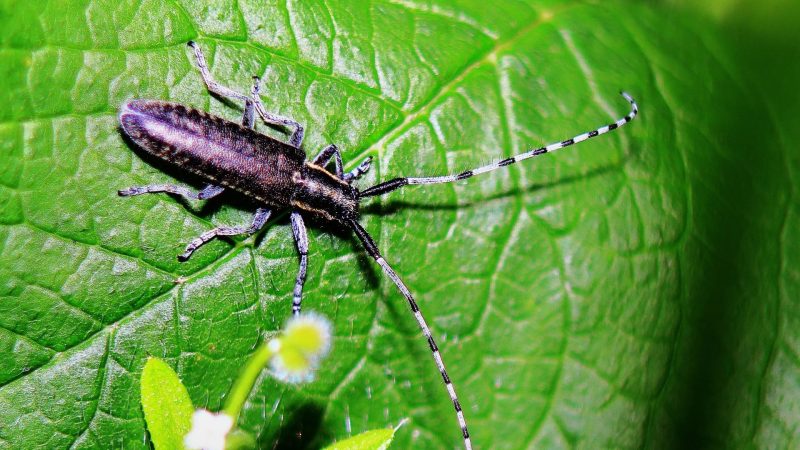
The larvae of longhorn beetles feed on the wood that they take shelter in. Adult ones munch on small branches and twigs. These beetles are like a maple tree, willow tree, ash tree, birch tree, poplar tree, elm tree, and horse chestnut tree.
They are also drawn to the bark of young trees, tree leaves, plant twigs, and short shrubberies.
Do Longhorn Beetles Eat Wood?
Longhorn beetles eat wood as they attack both old and young, healthy trees. Also, they are after stressed trees and newly cut trees, stumps, or logs.
The infestation on a tree collects a heap of sawdust around the base of the tree or the main stem. The grubs of longhorn beetles mainly eat wood as they leave holes that are 3/8-inch wide.
What Do Longhorn Beetles Do?
Longhorn beetles mainly damage the trees through the tunnels made by the larvae. These tunnels are usually on the tree’s sapwood and heartwood. A tunnel can be half an inch wide and 4 to 6 inches long.
As these tunnels spread around the tree, they can kill some branches and even the entire tree. A strong wind can easily break the branches and trees that have numerous galleries.
Small twigs also die because adult longhorn beetles like to munch on them. The females who lay eggs chew on the tree, and they leave pits and small wounds. This causes infection or tree disease that blackens the tree starting from the sap.
Due to the tunnels that these beetles make, you can see holes everywhere in the tree. You may even find them on exposed roots. There are small oval or round pits made by the mother beetle for laying eggs.
Some houses have wooden parts, and when moisture sinks in, longhorn beetles are attracted to them. The larvae of these beetles can live in the basement or other rooms.
Do House Longhorn Beetles Fly?
In summer, house longhorn beetles can fly. So, they can transfer from one place to another with ease.
Do Longhorn Beetles Make Noise?
Longhorn beetles make a squeaking noise. It’s also termed as a ‘stridulation’ which happens when their thorax moves forcefully. This sound is a sign of irritation and an impulse to predation pressure imposed by mammals or birds that see them as snacks.
Where Are Longhorn Beetles Found?
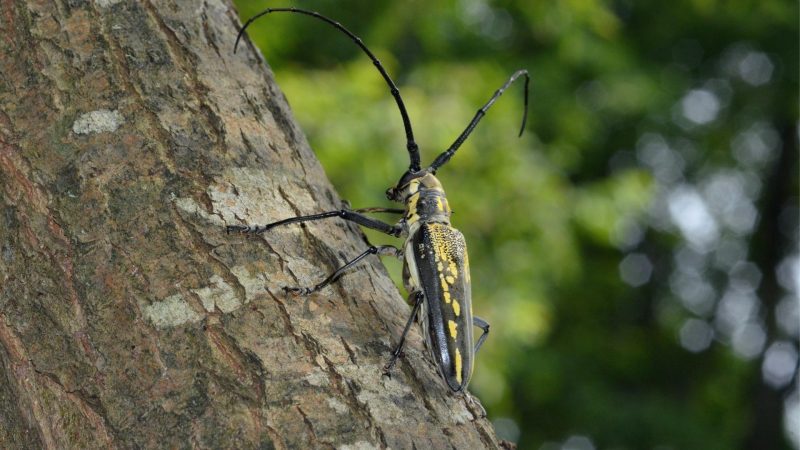
The main species of longhorn beetles are found in Asia, Africa, Europe, and North America. In addition, they’re widespread in the US.
How Are Longhorn Beetles Invasive?
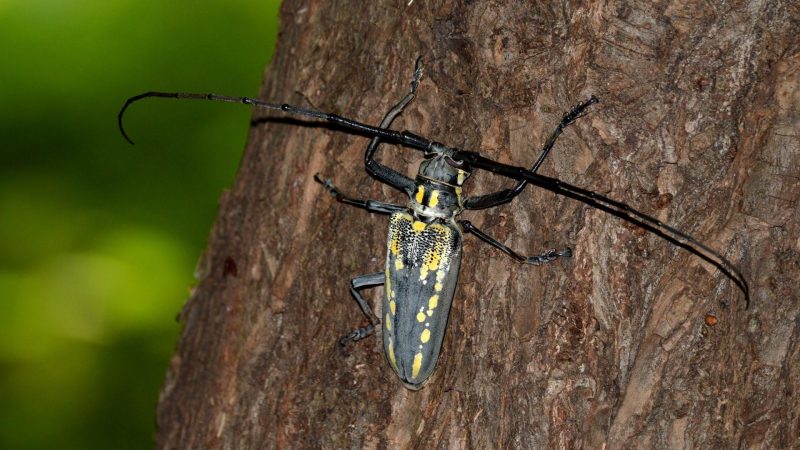
Longhorn beetles are rampant in China, Japan, and Korea, specifically in the wooded sections of the northern and eastern parts. In the USA, they’re extensive in Illinois, New York, and New Jersey.
These insects are also a problem in Toronto, Ontario. Somehow, it continues to spread throughout North America in ports and warehouses around the US.
The street trees attacked by longhorn beetles need treatment, so all the life phases of these pests can be eradicated. An invasion in urban areas like parks and streets of California can cause a lot of damage. The forest in the state is vulnerable to infestation, and native trees will be harmed.
It gets worse when they enter a forest. The money spent on containment and eradication can’t be taken back because the economic impact is more massive. There’s a big loss on export markets of different hardwood products.
Longhorn beetles are also invasive in European countries like France, Germany, Italy, and Poland. On the brighter side, eradication of these insects is successful in Austria, Belgium, The Netherlands, the UK, Finland, and Switzerland.
Are Longhorn Beetles Destructive?
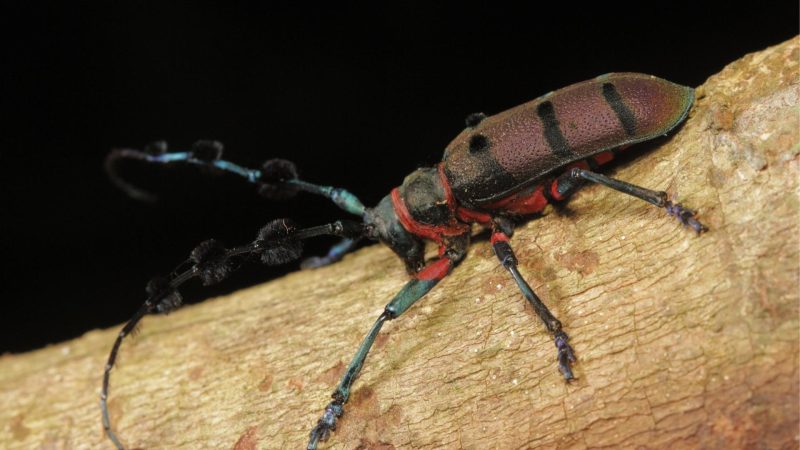
Longhorn beetles are destructive because they can kill a tree and destroy a forest. They feed on the same part of the tree throughout consecutive years. Thus, the infested part breaks off, and a whole tree even dies.
What Happens If You Get Bitten by a Beetle?
Beetles can bite humans when they feel threatened, and it can be painful. A blister arises from the bitten area due to the substance unleashed by the beetle. It heals in a few days, but it won’t cause further damage unless the person is allergic.
How Do You Get Rid of Longhorn Beetles?
Before getting started, you have to collect the following items:
- Ax or saw
- Fireplace or incinerator
Steps to Follow:
Step 1: The very first thing that you have to do is to confirm the presence of longhorn beetles. You have to be particular about its appearance to do so. This pest is usually found in logs, lumber, and trees.
Step 2: Inspect tree, wood, or a wooden surface for small holes that are typically 3/8-inch wide. When you open a piece of wood with tunnels, you’ll likely see larvae inside it.
Step 3: After inspecting a tree, you need to cut off the infected areas. You have to cut down the whole tree if the longhorn beetles have invaded all its parts.
Step 4: You can incinerate areas that are infested by longhorn beetles. It won’t only remove these pests but stop them from spreading.
Step 5: If there are parts of the tree that are free from infestation, spray them with the recommended insecticide.
Homemade Remedies for Longhorn Beetles
A homemade remedy for longhorn beetles involves an effective insecticide like Dominion . It’s done through soil drenching for long-term effects. 0.1 or 0.2 oz of insecticide is needed for every inch of the trunk.
The 2.5 oz solution should be combined with 4 or 5 gallons of water. Make a hole in the soil around the trunk of the tree. A pickaxe can help you to make holes.
Make holes that are large enough to hold the mixture. Generally, four to five gallons can fill five to ten holes. It must be done once a year to trees that are infected, and it’s also a way to protect other trees.
Summary
Longhorn beetles don’t pose any danger to humans but trees. The infestation of these beetles can wreak havoc on a forest and even trees in urban areas. It also affects the economy as wood exports can fall short of supply. Sadly, the successful eradication of these beetles can take years.
List of Sources
Stefan, M., Markham, C., Benjamin, R., Coath, J. (2014). Chapter 16 Case Study. Invasive Insects in Plant Biosecurity: The Asian Longhorned Beetle Eradication Program. University of Nebraska – Lincoln.
McCullough, D. (2014). Asian Longhorned Beetle: An Exotic Pest That We Don’t Want in Michigan. Michigan State University.
Paine, T. Asian Long-Horned Beetle. University of California – Center for Invasive Species Research.
- How to Get Rid of Copperheads | Practical Guide - August 27, 2023
- How to Get Rid of Corn Snakes | What Makes Them Aggressive? - August 27, 2023
- How to Get Rid of Alligators | Safety Measures and Removal Methods - July 16, 2023
